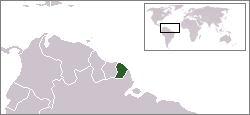Geography of France
Coordinates: 46°00′N 2°00′E / 46.000°N 2.000°E
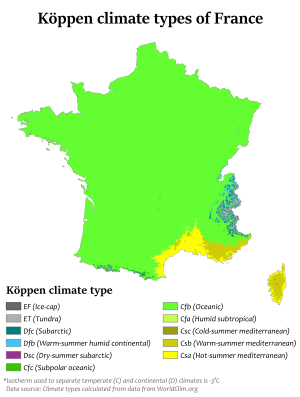
France is a country located partly in Western Europe which also has territory in South America, the Caribbean, and the Indian Ocean, as well as numerous territories of various status.
Area
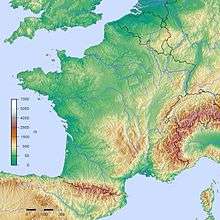
- Total area: 673,801 km2
- (Whole territory of the French Republic, including all the overseas departments and territories, but excluding the disputed French territory of Terre Adélie in Antarctica)
- Metropolitan France: 551,695 km2
- (Metropolitan - i.e. European - France only, French National Geographic Institute data)
- Metropolitan France: 543,965 km2
- (Metropolitan - i.e. European - France only, French Land Register data, which exclude lakes, ponds, glaciers larger than 1 km2
, and estuaries)
- (Metropolitan - i.e. European - France only, French Land Register data, which exclude lakes, ponds, glaciers larger than 1 km2
Physical geography of Metropolitan France
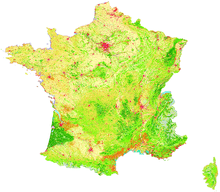
The terrain is mostly flat plains or gently rolling hills in the north and west and mountainous in the south (including the Pyrenees) and the east (the highest points being in the Alps).
Elevation extremes:
- Lowest point: Rhône river delta -2 m
- Highest point: Mont Blanc 4,808 m
Land use
- Arable land: 33.40%
- Permanent crops: 1.83%
- Other: 64.77% (2007)
Irrigated land: 26,420 km² (2007)
Total renewable water resources: 211 km3 (2011)
Freshwater withdrawal (domestic/industrial/agricultural): 31.62 km3/yr (19%/71%/10%) (512.1 m3/yr per capita) (2009)
Natural resources
Coal, iron ore, bauxite, zinc, uranium, antimony, arsenic, potash, feldspar, fluorspar, gypsum, timber, fish, gold
Natural hazards
Flooding, avalanches, midwinter windstorms, drought, forest fires in the south near the Mediterranean
Environment
Deforestation (major forest damage occurred as a result of severe December 1999 windstorm); air pollution from industrial and vehicle emissions; water pollution from urban wastes, deserttification, agricultural runoff
Flora and fauna
An open grassland during the Pleistocene Ice Age, France gradually became forested as the glaciers retreated starting in 10,000 BC. Clearing of the primeval forests began in Neolithic times, but they were still fairly extensive until major clearing began in medieval times.
By the 15th century, France had largely been denuded of its forests and was forced to rely on Scandinavia and their North American colonies for lumber. Significant remaining forested areas are in the Gascony region and north in the Alsace-Ardennes area. The Ardennes Forest was the scene of extensive fighting in both world wars.
In prehistoric times, France was home to large predatory animals such as wolves and brown bears, as well as herbivores such as elk. The larger fauna have disappeared outside of the Pyrenees Mountains where bears live as a protected species. Smaller animals include martens, wild pigs, foxes, weasels, bats, rodents, rabbits, and assorted birds.
The upper central part of this scene is dominated by the Paris Basin, which consists of a layered sequence of sedimentary rocks. Fertile soils over much of the area make good agricultural land. The Normandy coast to the upper left is characterized by high, chalk cliffs, while the Brittany coast (the peninsula to the left) is highly indented where deep valleys were drowned by the sea, and the Biscay coast to the southwest is marked by flat, sandy beaches.
Political geography
Internal divisions
-2016.svg.png)
France has several levels of internal divisions. The first-level administrative division of Integral France is regions. Besides this the French Republic has sovereignty over several other territories, with various administrative levels.
- Metropolitan (i.e. European) France is divided into 12 régions and 1 territorial collectivity, Corsica. However, Corsica is referred to as a region in common speech. These regions are subdivided into 96 départements, which are further divided into 329 arrondissements, which are further divided into 3,879 cantons, which are further divided into 36,568 communes (as of 1/1/2004).
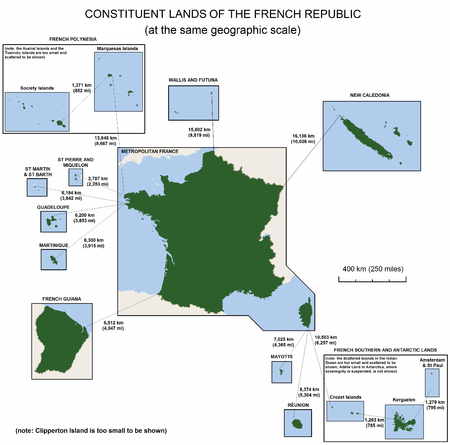
- Five overseas regions (régions d'outre-mer, or ROM): Guadeloupe, French Guiana, Martinique, Mayotte, and Réunion, with identical status to metropolitan regions. Each of these overseas regions also being an overseas département (département d'outre-mer, or DOM), with the same status as a département of metropolitan France. This double structure (région/département) is new, due to the recent extension of the regional scheme to the overseas départements, and may soon transform into a single structure, with the merger of the regional and departmental assemblies. Another proposed change is that new départements are created such as in the case of Réunion, where it has been proposed to create a second département in the south of the island, with the région of Réunion above these two départements.
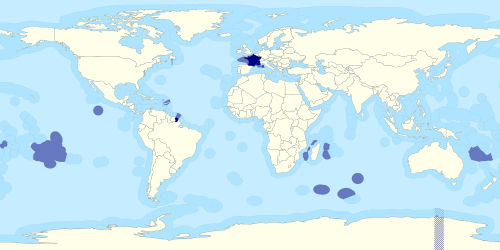
- Four overseas collectivities (collectivités d'outre-mer, or COM): Saint-Pierre and Miquelon, Saint Barthélemy, Saint Martin, and Wallis and Futuna.
- One overseas "country" (pays d'outre-mer, or POM): French Polynesia. In 2003 it became an overseas collectivity (or COM). Its statutory law of 27 February 2004 gives it the particular designation of overseas country inside the Republic (or POM), but without legal modification of its status.
- One sui generis collectivity (collectivité sui generis): New Caledonia, whose status is unique in the French Republic.
- One overseas territory (territoire d'outre-mer, or TOM): the French Southern and Antarctic Lands divided into 5 districts: Kerguelen Islands, Crozet Islands, Amsterdam Island and Île Saint-Paul, Adélie Land, and the Scattered islands (Banc du Geyser, Bassas da India, Europa, Juan de Nova, Glorioso, and Tromelin).
- One uninhabited island in the Pacific Ocean off the coast of Mexico which belongs directly to the central State public land and is administered by the high-commissioner of the French Republic in French Polynesia: Clipperton.
Boundaries
- Land boundaries:
- Total: 3,966.2 kilometres (2,464.5 mi)
- 2,751 kilometres (1,709 mi) (metropolitan), 1,205 kilometres (749 mi) (French Guiana) 10.2 kilometres (6.3 mi) (Saint Martin)
- Border countries:
- Andorra 55 kilometres (34 mi), Belgium 556 kilometres (345 mi), Germany 418 kilometres (260 mi), Italy 476 kilometres (296 mi), Luxembourg 69 kilometres (43 mi), Monaco 6 kilometres (3.7 mi), Spain 646 kilometres (401 mi), Switzerland 525 kilometres (326 mi) (metropolitan)
- Brazil 649 kilometres (403 mi), Suriname 556 kilometres (345 mi), 1,183 kilometres (735 mi) (French Guiana)
- Sint Maarten 10.2 kilometres (6.3 mi) (Saint Martin)
- Coastline: 3,427 kilometres (2,129 mi) (metropolitan), 378 kilometres (235 mi) (French Guiana), 306 kilometres (190 mi) (Guadeloupe), 350 kilometres (220 mi) (Martinique), 207 kilometres (129 mi) (Réunion)
- Maritime claims:
- Territorial sea: 12 nmi (22.2 km; 13.8 mi)
- Contiguous zone: 24 nmi (44.4 km; 27.6 mi)
- Exclusive economic zone: 200 nmi (370.4 km; 230.2 mi); does not apply to the Mediterranean
- Continental shelf: 200 metres (660 ft) depth or to the depth of exploitation
Extreme points
This is a list of the extreme points of France; the points that are farther north, south, east or west than any other location.
France (mainland Europe)
- Northernmost point — Bray-Dunes, Nord at 51°05′N 2°32′E / 51.083°N 2.533°E
- Southernmost point — Puig de Comanegra, Lamanère, Pyrénées-Orientales at 42°20′N 2°31′E / 42.333°N 2.517°E
- Westernmost point — Pointe de Corsen, Plouarzel, Finistère at 48°24′N 4°47′W / 48.400°N 4.783°W
- Easternmost point — Lauterbourg, Bas Rhin at 48°58′N 8°13′E / 48.967°N 8.217°E
France (metropolitan)
- Northernmost point — Bray-Dunes, Nord at 51°05′N 2°32′E / 51.083°N 2.533°E
- Southernmost point — Îles Lavezzi (off Corsica), Bonifacio, Corse-du-Sud at 41°20′N 9°15′E / 41.333°N 9.250°E
- Westernmost point — Isle of Ushant (off Brittany), Lampaul-Plouarzel, Finistère at 48°27′N 5°08′W / 48.450°N 5.133°W
- Easternmost point — San-Giuliano (near Cervione), Haute-Corse at 42°17′N 9°33′E / 42.283°N 9.550°E
France (including départements d'outre mer)
- Northernmost point — Bray-Dunes, Nord at 51°05′N 2°32′E / 51.083°N 2.533°E
- Southernmost point — Saint-Joseph, Réunion at 22°23′S 55°38′E / 22.383°S 55.633°E
- Westernmost point — Pointe-Noire, Guadeloupe at 16°16′N 61°48′W / 16.267°N 61.800°W
- Easternmost point — Sainte-Rose, Réunion at 21°11′S 55°50′E / 21.183°S 55.833°E
France (territory of the French Republic, including collectivités territoriales and pays et territoires d'outre-mer)
- Northernmost point : Bray-Dunes, Nord at 51°05′N 2°32′E / 51.083°N 2.533°E
- Southernmost point : îles de Boynes, Kerguelen Islands, French Southern and Antarctic Lands at 50°01′S 68°52′E / 50.017°S 68.867°E
- Westernmost point : Toloke, Futuna, Wallis and Futuna at 14°42′S 178°33′W / 14.700°S 178.550°W
- Easternmost point : Hunter Island, New Caledonia at 22°31′S 172°6′E / 22.517°S 172.100°E
Antipodes
The land hemisphere—the half of the Earth with the most land—is centred on Nantes. Thus the antipodes of France are in the middle of the water hemisphere in the South Pacific. The only significant land mass antipodal to metropolitan France is the Chatham Islands of New Zealand, corresponding to an area north of Montpellier including much of the Cévennes National Park, though the antipodes of the uninhabited Bounty Islands are between Tours, Orléans, and Le Mans, and those of the likewise uninhabited Antipodes Islands are in Normandy, near Saint-Saëns outside of Rouen.
However, French overseas possessions are widespread enough that Clipperton Island and Réunion are passably close to being antipodal to each other, and several are antipodal to other countries. The Indonesian island of Buru, for example, finds its antipodes within French Guiana, as do a few smaller islands. The French Antarctic territory of Kerguelen is opposite the border between the Canadian provinces of Alberta and Saskatchewan and the US state of Montana. New Caledonia and the Loyalty Islands overlap Mauritania and southern Western Sahara, with the Mauritanian town of Zoueratte corresponding to the Isle of Pines. Wallis and Futuna are antipodal to Niger north of Niamey (spec. Féfandou near Ouallam).
In French Polynesia, the Marquesas are opposite central Ethiopia; the Society Islands of northern Sudan, with Tahiti close to antipodal with Al Dabbah on the Nile. The Austral Islands cover southern Egypt and Saudi Arabia. The Tuamotus cover a broad swath of Sudan, northern Eritrea, the Red Sea, and Saudi Arabia, with Khartoum antipodal to Rangiroa and Jeddah close to Tematangi. The Gambier Islands overlap Arabia, with Mangareva between Riyadh and Mecca.
See also
- Regions of France
- List of fifteen largest French metropolitan areas by population
- Géoportail
- Institut géographique national
Lists:
General:
References
External links
| Wikibooks has more on the topic of: Geography of France |
- (French) GéoPortail - Geography portal of France, high altitude imagery, maps ...
- A detailed map of France showing all régions and numbered départements, including their préfectures.
